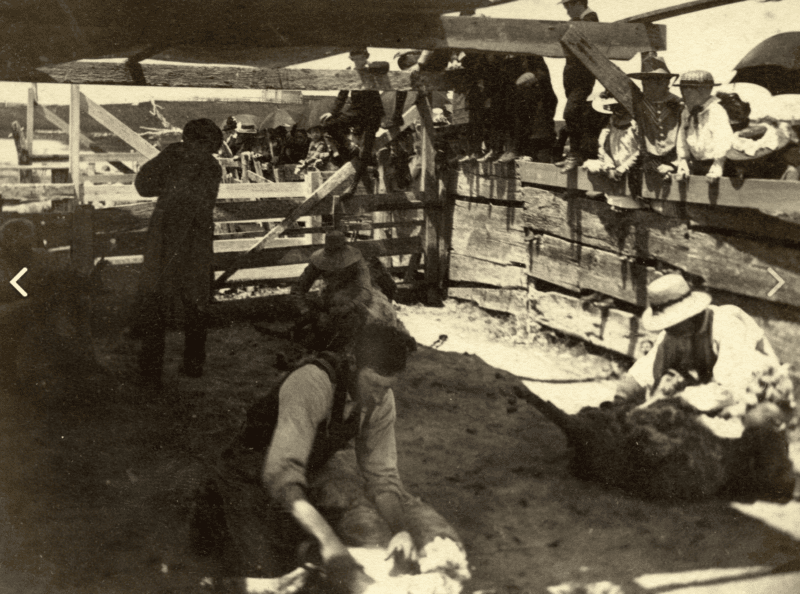Whaling made Nantucket one of the busiest ports in the world during the 1800s, but the men who first settled the island were not seafarers. Their primary endeavors were pastoral, and raising sheep became their first industry.
The early settlers’ interest in sheep husbandry is evident even in the way they divided, or rather did not divide, the island heathland. After land was granted for homesteads, the remainder of Nantucket was kept as an open pasture held in common by the settlers. But not everyone had an equal share.
The ten original purchasers of Nantucket held a meeting on the mainland in 1659 during which they chose ten partners; these men were the “Twenty First Purchasers.” Subsequently, in order to induce craftsmen to join their venture, these twenty men offered half-shares to fourteen artisans. Therefore, in Nantucket’s early days there were 27 shares (20 full shares and 14 half shares) holding the common land.
Originally each share was made up of 720 “sheep commons,” one sheep common being equal to the 1-1/2 acres needed to pasture one sheep. Each shareholder was permitted only the number of animals that his share of the common land could support: four geese for every sheep common, one sheep per common, one cow for every eight sheep commons, and one horse for every sixteen sheep commons.
All the shareholders’ animals grazed together on the heath, distinguished only by earmarks. The sheep were left virtually untended all winter long. Often the animals wandered into town, pestering residents. If a door was left open, a sheep would walk right into the house. There’s an account of one prisoner in the Town Gaol who sent word to the jailer if he did not mend the wall to keep the sheep out, he was going home. Each winter sheep were lost: buried in snowdrifts or pushed into the sea during a fierce storm. The winter of 1779-1780 was especially severe, and over half the sheep and many lambs perished.
The deprivation of the Revolutionary War years reduced the number of sheep on Nantucket from about 10,000 in 1775 to 3,000 in 1784. By 1800 the flock had recovered to 16,000, but again diminished to about 8500, in part because of the dissolution of the common land system. From the mid-1800s on, the number of sheep on Nantucket declined partially in response to increased supplies of mutton from the west combined with a poor market for wool on the mainland.
But from the late 1600s through the early 1800s there were plenty of sheep on Nantucket, and they had to be shorn. The annual sheep shearing was one of the few opportunities to combine hard labor with celebration, and the Sheep Shearing Festival soon became an early summer event that even off-islanders came to enjoy.
The Shearing Festivals were always held the Monday and Tuesday closest to June 20. The first recorded shearing holiday took place in 1696, the last in 1847. At one time there were so many sheep here that two shearing pens were required—one in the east at Gibb’s Pond and the other in the west at Maxy’s Pond in an enormous enclosure that accomodated both the east and west flocks.
The sheep pen used during shearing was comprised of circular fences in a sort of labyrinth with the pens of individual owners located around the exterior circle. A clerk and assistants identified sheep as the pens were filled, and an account was kept of every man’s stock.
Friday and Saturday before the festival the sheep were rounded up, separated from the lambs, and thoroughly washed in a nearby pond. Sunday they dried in their respective shear pens, and Monday the festivities began
People came from across the island to attend the Shearing Festival; some walked, some rode, and a good number came in “tip carts.” These carts were two-wheeled vehicles in which the driver stood, the adult passengers rode sitting in house chairs, and the children stood in the back hanging onto ropes to keep from falling out.
Families put up tents around the shear pen in which the women assembled the day’s feast that often included roast pig, oysters, home-brewed cinnamon beer, three-cornered shearing buns, pies, and cakes. There were stands to sell baked goods and preserves. Many of the shearers traveled from off-island and could take a fleece in less than ten minutes. Some of the sheep were quite wild from roaming the heath, and sometimes came close to injuring the shearer. There was music and dancing as well as games.
All other work stopped for the festival. The Nantucket Inquirer reported before one shearing: “The orgies of the mutton-worshippers are beginning to burst forth, and all the wooly world is in an agony of helter-skelterishness…Consequence is, no paper next Saturday.”
The Annual Shearing Festival lasted Monday and Tuesday, and then the sheep were released to again wander the commons and the Nantucketers went back to work until the following June signalled the return of the feasting and celebration.



